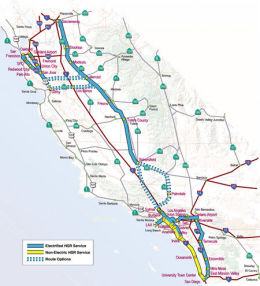Posted 4th July 2008 | 4 Comments
Californians to vote on high-speed rail plans

VOTERS on America’s west coast look likely to get the chance in November to give their views on ambitious plans to build a $42-$45 billion (£21-£22.7 billion) high-speed rail system — including connecting San Francisco and Los Angeles.
Opposing Republicans were defeated 8-4 in the California Senate’s Transportation and Housing Committee.
Urged on by Democrat Senator Leland Yee, from San Francisco, the committee agreed that voters should be asked to approve a $9.95 billion (£3 billion) bond.
If approved, this would be used to develop the “spine” of a proposed 800-mile high-speed rail system, running from Anaheim to Los Angeles to San Jose and San Francisco through the Antelope and San Joaquin valleys — serving a state with a population of 37 million people, including 10 million in Los Angeles and 7.2 million in the San Francisco Bay area.
The proposal will be Proposition 1 in a ballot to be considered by California’s voters on 4 November.
“The high speed rail bond has always been about finding ways to get millions of people out of cars and airplanes and into a cost-saving and environmentally-sound transportation portal,” said Senator Yee.
“A piecemeal approach is not what is best for commuters, visitors, or the economy, and is certainly not what is best for our environment. As an advocate for high speed rail, I will continue to be steadfast in securing the San Francisco to Los Angeles corridor of the ‘bullet train’ and then branching out to other cities,” said the Senator.
Christine Kehoe (Democrat Senator, San Diego) said she and other ‘bullet train’ supporters cited the electric train’s low air emissions and ability to move millions of passengers from north to south to serve a burgeoning state population.
Robert Cruickshank, of the California High Speed Rail Blog, and contributing editor to Calitics.com, said: “Los Angeles to San Francisco is necessary to be the spine of the project and the notion of building it in pieces was always a poor approach to the project’s politics and efficiency.
“The original plan and amendment made by Senator Yee are sound,” added Cruickshank. “Los Angeles to San Francisco first, then the extensions to San Diego and Sacramento as a guaranteed Phase II. Rome wasn’t built in a day, neither will high speed rail.”
Reader Comments:
Views expressed in submitted comments are that of the author, and not necessarily shared by Railnews.

M Foster, Winsford UK, UK
Las Vegas desperatley needs a rail link, how can a city of such huge size and constantly developing not have a service, I appreciate that there are frequent air services between L.A and Vega$ but these air services have to be put in to context that given the world environment, global warming etc alternatives to air travel must be sought and developed
Tom West,
Peter M is right - there should be long term plans to extend the system up the west coast and towards the gulf.... but the system has to start somewhere. SF-LA is the best place, and will show that high-speed rail can work in the USA, no matter how much people comment about car culture or population density.
Mark, Vancouver/ British Columbia
I hope they are going to build a MAGLEV! so people can travel from one place to another with the speed of airplane (around 500 km/h)!
REMEMBER, BUILDING A MAGLEV IS ONLY A ONE TIME, BILLIONS OF DOLLARS OF INVESTMENT... BUT STILL BETTER THAN PEOPLE SPENDING BILLIONS AND POSSIBLY TRILLIONS OF $$ ON OIL EVERYDAY!
Peter M, Bellevue, WA, USA
It's not in the plans now, but we need the line north of Sacramento, connecting Vancouver, BC to San Diego
For east-west trips, a trunk line through Salt Lake City and Denver (or Cheyenne) might have west-side offshoorts to Las Vegas NV and Anaheim, to Reno and Sacramento, and to Boise and Pasco, with further connections to Portland, Seattle, Spokane.